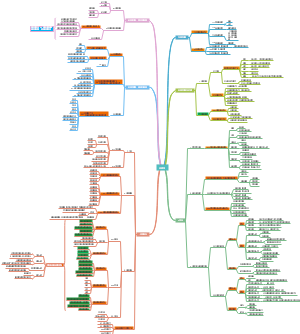导图社区 新编英语语法教程(大学教材)
- 844
- 21
- 8
- 举报
新编英语语法教程(大学教材)
大学英语语法笔记,内容详实,结构清晰,逻辑严密,非常值得学习,现在不收藏,你还在等什么呢?
编辑于2021-06-28 17:20:17- 相似推荐
- 大纲
Grammatical Hierarchy
morpheme
Free Morpheme
本本身具有完整意义,并能够作为简单词单独使用:boy,chair
充当词根→kindness →friendly
和其他自由词素相组合→复合词:bookshop,take-home
Bound Morpheme
本本身没有词义,或者没有完整词义,不能单独存在,而必须粘附在其他形式上。
Affix
inflectional affix
-ed -ing -s/es
derivational affix
prefix
anti,post,co
suffix
less,ly,ness,
Combining Form
arch,auto,dict,duct,graph,micro,tele
word
构词法
Simple Word
由单一自由语素构成
By,Far,Hand
Derivative
由词根加派生词缀构成
Unfair. Discover. Antiwar. Supermarket. Enable.
Compound Word
由两个或两个以上的自由词素构成
Whoever.Deadline. Another. Moreover.
语法功能
封闭词类
所有的功能词。没有完整的词汇意义,但有语法意义。
preposition
in,of,with
pronoun
you,he,it
determiner
a,the,this
conjection
and,but,because
auxiliary
do,can,may
其他词类
基数词
序数词
感叹词
开放词类
各种实义词
Noun
smith,man,faith
Adjective
old,tall,big
Adverb
here,late,really
Main Verb
work,give,talk
phrase
NP
以名词为中心的词组,只由一个中心词构成
结构形式:限定词+前置修饰语+名词+后置修饰语→all the college students
VP
以主动词为中心词的词组
简单动词词组→she looks pale
复杂动词词组→it is getting dark.
动词形式
限定动词词组
有“时”的标记,受主语的人称和数的限制。
非限定动词词组
第一个词如果是一种不变的动词形式→We went there to see a film.
AP
以形容词为中心的词组
结构形式→(修饰语)+形容词+(后置修饰语/补足成分)→The weather is fine today.
Adv P
以副词为中心词的词组
结构形式→(修饰词)+副词+(后置修饰语)→He spoke loudly and clearly.
PP
以借此为中心词的词组
结构形式→(修饰语)+介词+补足成分→ Do you think of you can borrow some money from your friend?
clause
Independent Clause and Dependent Clause
独立分句→不依附于其他结构而独立存在的分句
He knows everyhing about it.
That hat does not fit,you may try another one
从属分句→ 从属于其他结构的分句
I am sure he knows everything about it.
If that hat does not fit ,try another .
Simple Clause and Complex Clause
简单分句→主谓结构
It is not true
复杂分句→有其他主谓结构作为分句成分的分句
What you said is not true
Main Clause and Subordinate Clause
Finite Clause.Non-finite Clause、无动词分句
①→以限定动词作谓语的分句
②→以非限定动词词组(动词不定式、-ing 分词、-ed 分词)做谓语动词的分句
I sighed the psper to get the license
③→不带任何形式的动词词组作谓语动词
Hungry and exhausted,the climbers returned.
sentence
Full Stentence and Minor Stenence
①→至少包括一个完整的主谓结构
②→不具备完整主谓结构→Last night./No smoking.
简单句、并列句、复杂句、并列复杂句(完全句)
①→由一个主谓结构并且各个成分均由词组构成的句子。
②→由两个或两个以上的简单句由并列连词和其他并列手段连接起来,便构成并列句
③→某个句子成分直接由从属分句表示
④→一个并列句,如果包含一个或一个以上的复杂句作为并列成分
clause element
Central Element
S
人称主语(Personal Subject)&非人称主语(Non-personal Subject)
施动主语(Agentive Subject)&受动主语(Recipient Subject)
时间主语(Temporal Subject)&地点主语(Locative Subject)
工具主语(Instrumental Subject)&事件主语(Eventive Subject)
V
简单动词词组
复杂动词词组
限定动词词组
非限定动词词组
O
受动宾语(Recipient Object)
结果宾语(Resultant Object)
使役宾语(Causative Object)
转喻宾语(Metonymic Object)
E.g. wipe off the table 擦桌子
同源宾语(Cognate Object)
C
主语补语(Subject Complement)
宾语补语(Object Complement)
A
结构性/强制性状语(Structural/Obligatory Adverbial)
语法上不可删去
修饰性状语(Depictive Adverbial/Adjunct)
Peripheral Element
评注性状语(Stance Adverbial/Disjunct)
连接性状语(Linking Adverbial/Conjunct)
Preface
Tags
Parenthetical
Discourse Markers
Vocatives
Examples
SV: I cried.
SVA: I lived in Nanjing.
SVO: They wanted us to learn economics
SVC: Joe supposed the stranger to be friendly.
SVOO: I give you a book.
SVOC: I consider you intelligent.
SVOA: I put my cup on the desk.
subject-verb concord
Three principles for subject-verb concord
语法一致(Grammatical)
语法一致原则主要看名词词组的名词中心词
意义一致(Notional )
就近原则(Principe of Proximity)
主谓一致原则往往受到习惯用法、语体、语域得制约
①disease, subject, geography, and other words
②collective noun
③coordination structure
Conjunctions
coordinator(and, or, but, so, nor, yet, for)
subordinator(if, though/although, when, while, as, since....)
Rule of coordinate structure
意义相关、层次相同、句法功能相同(有时并列结构层次并不相同)
④NPs containing quantity(definite&indefinite)
⑤ finite nominal clause used as the subject
⑥nonfinite nominal clause used as the subject
⑦S-V agreement in relative clause
⑧S-V agreement in cleft sentence
⑨S-V agreement in there-be sentence









